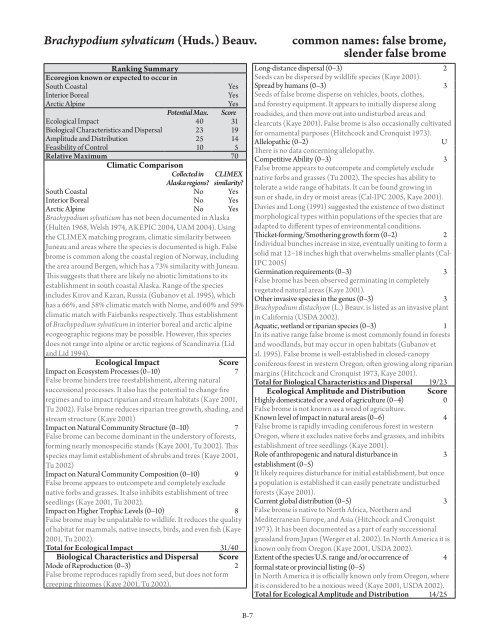Invasiveness Ranking System for Non-Native Plants of Alaska
Invasiveness Ranking System for Non-Native Plants of Alaska
Invasiveness Ranking System for Non-Native Plants of Alaska
Create successful ePaper yourself
Turn your PDF publications into a flip-book with our unique Google optimized e-Paper software.
Brachypodium sylvaticum (Huds.) Beauv.<strong>Ranking</strong> SummaryEcoregion known or expected to occur inSouth CoastalInterior BorealArctic AlpineYesYesYesPotential Max. ScoreEcological Impact 40 31Biological Characteristics and Dispersal 23 19Amplitude and Distribution 25 14Feasibility <strong>of</strong> Control 10 5Relative Maximum 70Climatic ComparisonCollected in<strong>Alaska</strong> regions?CLIMEXsimilarity?South Coastal No YesInterior Boreal No YesArctic Alpine No YesBrachypodium sylvaticum has not been documented in <strong>Alaska</strong>(Hultén 1968, Welsh 1974, AKEPIC 2004, UAM 2004). Usingthe CLIMEX matching program, climatic similarity betweenJuneau and areas where the species is documented is high. Falsebrome is common along the coastal region <strong>of</strong> Norway, includingthe area around Bergen, which has a 73% similarity with Juneau.This suggests that there are likely no abiotic limitations to itsestablishment in south coastal <strong>Alaska</strong>. Range <strong>of</strong> the speciesincludes Kirov and Kazan, Russia (Gubanov et al. 1995), whichhas a 66%, and 58% climatic match with Nome, and 60% and 59%climatic match with Fairbanks respectively. Thus establishment<strong>of</strong> Brachypodium sylvaticum in interior boreal and arctic alpineecogeographic regions may be possible. However, this speciesdoes not range into alpine or arctic regions <strong>of</strong> Scandinavia (Lidand Lid 1994).Ecological ImpactScoreImpact on Ecosystem Processes (0–10) 7False brome hinders tree reestablishment, altering naturalsuccessional processes. It also has the potential to change fireregimes and to impact riparian and stream habitats (Kaye 2001,Tu 2002). False brome reduces riparian tree growth, shading, andstream structure (Kaye 2001)Impact on Natural Community Structure (0–10) 7False brome can become dominant in the understory <strong>of</strong> <strong>for</strong>ests,<strong>for</strong>ming nearly monospecific stands (Kaye 2001, Tu 2002). Thisspecies may limit establishment <strong>of</strong> shrubs and trees (Kaye 2001,Tu 2002)Impact on Natural Community Composition (0–10) 9False brome appears to outcompete and completely excludenative <strong>for</strong>bs and grasses. It also inhibits establishment <strong>of</strong> treeseedlings (Kaye 2001, Tu 2002).Impact on Higher Trophic Levels (0–10) 8False brome may be unpalatable to wildlife. It reduces the quality<strong>of</strong> habitat <strong>for</strong> mammals, native insects, birds, and even fish (Kaye2001, Tu 2002).Total <strong>for</strong> Ecological Impact 31/40Biological Characteristics and Dispersal ScoreMode <strong>of</strong> Reproduction (0–3) 2False brome reproduces rapidly from seed, but does not <strong>for</strong>mcreeping rhizomes (Kaye 2001, Tu 2002).B-7common names: false brome,slender false bromeLong-distance dispersal (0–3) 2Seeds can be dispersed by wildlife species (Kaye 2001).Spread by humans (0–3) 3Seeds <strong>of</strong> false brome disperse on vehicles, boots, clothes,and <strong>for</strong>estry equipment. It appears to initially disperse alongroadsides, and then move out into undisturbed areas andclearcuts (Kaye 2001). False brome is also occasionally cultivated<strong>for</strong> ornamental purposes (Hitchcock and Cronquist 1973).Allelopathic (0–2)UThere is no data concerning allelopathy.Competitive Ability (0–3) 3False brome appears to outcompete and completely excludenative <strong>for</strong>bs and grasses (Tu 2002). The species has ability totolerate a wide range <strong>of</strong> habitats. It can be found growing insun or shade, in dry or moist areas (Cal-IPC 2005, Kaye 2001).Davies and Long (1991) suggested the existence <strong>of</strong> two distinctmorphological types within populations <strong>of</strong> the species that areadapted to different types <strong>of</strong> environmental conditions.Thicket-<strong>for</strong>ming/Smothering growth <strong>for</strong>m (0–2) 2Individual bunches increase in size, eventually uniting to <strong>for</strong>m asolid mat 12–18 inches high that overwhelms smaller plants (Cal-IPC 2005)Germination requirements (0–3) 3False brome has been observed germinating in completelyvegetated natural areas (Kaye 2001).Other invasive species in the genus (0–3) 3Brachypodium distachyon (L.) Beauv. is listed as an invasive plantin Cali<strong>for</strong>nia (USDA 2002).Aquatic, wetland or riparian species (0–3) 1In its native range false brome is most commonly found in <strong>for</strong>estsand woodlands, but may occur in open habitats (Gubanov etal. 1995). False brome is well-established in closed-canopyconiferous <strong>for</strong>est in western Oregon, <strong>of</strong>ten growing along riparianmargins (Hitchcock and Cronquist 1973, Kaye 2001).Total <strong>for</strong> Biological Characteristics and Dispersal 19/23Ecological Amplitude and Distribution ScoreHighly domesticated or a weed <strong>of</strong> agriculture (0–4) 0False brome is not known as a weed <strong>of</strong> agriculture.Known level <strong>of</strong> impact in natural areas (0–6) 4False brome is rapidly invading coniferous <strong>for</strong>est in westernOregon, where it excludes native <strong>for</strong>bs and grasses, and inhibitsestablishment <strong>of</strong> tree seedlings (Kaye 2001).Role <strong>of</strong> anthropogenic and natural disturbance inestablishment (0–5)It likely requires disturbance <strong>for</strong> initial establishment, but oncea population is established it can easily penetrate undisturbed<strong>for</strong>ests (Kaye 2001).Current global distribution (0–5) 3False brome is native to North Africa, Northern andMediterranean Europe, and Asia (Hitchcock and Cronquist1973). It has been documented as a part <strong>of</strong> early successionalgrassland from Japan (Werger et al. 2002). In North America it isknown only from Oregon (Kaye 2001, USDA 2002).Extent <strong>of</strong> the species U.S. range and/or occurrence <strong>of</strong><strong>for</strong>mal state or provincial listing (0–5)In North America it is <strong>of</strong>ficially known only from Oregon, whereit is considered to be a noxious weed (Kaye 2001, USDA 2002).Total <strong>for</strong> Ecological Amplitude and Distribution 14/2534
















